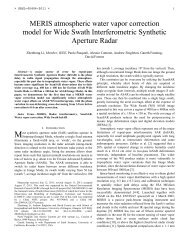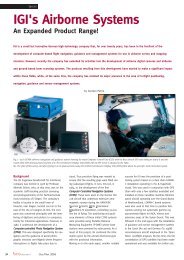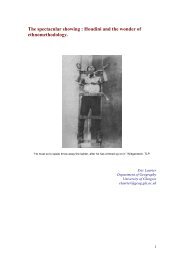Mobile Mapping Systems - University of Glasgow
Mobile Mapping Systems - University of Glasgow
Mobile Mapping Systems - University of Glasgow
You also want an ePaper? Increase the reach of your titles
YUMPU automatically turns print PDFs into web optimized ePapers that Google loves.
Fig. 6 – A SICK LMS 291 2D laser scanner set on its side to produce a vertical<br />
pr<strong>of</strong>ile comprising a series <strong>of</strong> measured range and angular values to one side<br />
<strong>of</strong> a mobile mapping vehicle. (Source: SICK)<br />
Laser Ranging & Scanning Devices<br />
The numerous, varied and well-established types <strong>of</strong> tripod-mounted 3D 3D<br />
laser laser scanners scanners that are in widespread use by land surveyors undertaking<br />
terrestrial or ground-based laser scanning – including both<br />
panoramic and camera-type laser scanners; the use <strong>of</strong> the phase measuring<br />
technique for short distances; and the need for both horizontal<br />
and vertical angles to be measured – have had little part to play in<br />
mobile mapping systems. Indeed the 3D laser scanners that are available<br />
at present for surveying work can only be used for static measurements<br />
in their native 3D operational mode, even when mounted on a<br />
vehicle - since the scanning operation at a single fixed location <strong>of</strong>ten<br />
takes several minutes. However a very small number <strong>of</strong> 3D laser scanners<br />
from the German Faro and Z+F companies have been operated on<br />
mobile mapping vehicles, but with their horizontal (azimuth) angular<br />
movements disabled – which effectively makes them into 2D laser scanners.<br />
Indeed the main emphasis in mobile mapping is on the use <strong>of</strong> 2D 2D laser laser<br />
scanners scanners that can very rapidly acquire range or elevation pr<strong>of</strong>iles comprising<br />
the distance and angular values measured within a single 2D<br />
plane. These pr<strong>of</strong>ile measurements are carried out using the laser scanner<br />
to measure the required distances and angles simultaneously within<br />
a series <strong>of</strong> successive parallel planes intersecting the road surfaces,<br />
pavements, “street furniture”, buildings and vegetation that are located<br />
adjacent to the roads or streets along which the mobile mapping vehi-<br />
[a]<br />
Latest News? Visit www.geoinformatics.com<br />
Fig. 7 – (a) The Riegl Q120 2D laser scanner which is equipped with a<br />
laser rangefinder and a continuously rotating polygon mirror with its<br />
attached angular encoder to produce successive range or elevation<br />
pr<strong>of</strong>iles as the mapping vehicle is driven forward.<br />
(b) The operating principle <strong>of</strong> the Riegl Q120 2D laser scanner.<br />
(c) A diagram showing the coverage <strong>of</strong> the pr<strong>of</strong>iles generated by two<br />
Q120 laser scanners, pointing in opposite directions at right angles to<br />
the direction <strong>of</strong> travel <strong>of</strong> the mobile mapping vehicle. (Source: Riegl)<br />
[b]<br />
35<br />
Article<br />
cles are being driven. Indeed, in many respects, the 2D laser scanners<br />
that are mounted on mobile mapping vehicles are, in principle, quite<br />
similar to the laser scanners that are being used in airborne laser scanning<br />
– except that they are usually being operated over distances <strong>of</strong> a<br />
few tens <strong>of</strong> metres, instead <strong>of</strong> the several hundreds or thousands <strong>of</strong><br />
metres that are encountered in airborne laser scanning. As with airborne<br />
laser scanning, the third dimension to the captured pr<strong>of</strong>ile data<br />
is being created by the forward movement <strong>of</strong> the vehicular platform on<br />
which the 2D laser scanner is mounted. The location <strong>of</strong> each new range<br />
pr<strong>of</strong>ile is being measured continuously (and very accurately) using an<br />
integrated suite <strong>of</strong> positioning devices – comprising a GPS or GNSS<br />
receiver, an IMU; and an odometer or DMI device – as the vehicle travels<br />
forward.<br />
The 2D laser scanners that are probably the most commonly used in<br />
mobile mapping are those manufactured by the SICK company, which is<br />
based in Waldkirch, Germany. The SICK company makes an almost bewildering<br />
range <strong>of</strong> laser scanners - including bar code scanners; scanners<br />
for displacement and volumetric measurements; and scanners that are<br />
designed for proximity determination and safety purposes - together<br />
with numerous other types <strong>of</strong> encoders, switches, controllers and sensors<br />
that are designed for a wide range <strong>of</strong> industrial, logistic and commercial<br />
applications. Certain models in the SICK LMS (Laser Measurement<br />
<strong>Systems</strong>) series <strong>of</strong> laser scanner are designed specifically for outdoor<br />
use, the LMS 291 model being that mainly used in mobile mapping [Fig.<br />
6]. This scanner combines (i) a rapid firing laser rangefinder using the<br />
time-<strong>of</strong>-flight (TOF) distance measuring principle; with (ii) a rotating mirror<br />
whose angular directions are also being measured continuously using<br />
an angular encoder. Using this technology, the LMS 291 generates a fanshaped<br />
scanning angle <strong>of</strong> 180 degrees within its 2D scanning plane and<br />
can measure ranges <strong>of</strong> up to 80 m to objects having a reflectivity <strong>of</strong><br />
70%.; 60 m to objects (such as a wooden house) with a reflectivity <strong>of</strong><br />
40%; and 30 m to objects with 10% reflectivity. The measuring resolution<br />
in range <strong>of</strong> the LMS 291 model is stated to be 1 cm, while the accuracy<br />
is +/- 6 cm. An additional LMI controller can be supplied to control<br />
the operation <strong>of</strong> multiple LMS scanners. Still longer-range 2D laser scanners<br />
are available from LASE GmbH, which is another company in the<br />
SICK Group based in Wesel, Germany. The LASE LD-LRS laser scanner<br />
can measure ranges up to 250 m with suitable highly reflective objects;<br />
110 m to objects with 20% reflectivity; and 80 m to objects with 10%<br />
reflectivity, and has a 300 degree scanning angle. Still another company<br />
in the SICK Group, Ibeo, based in Hamburg, Germany also <strong>of</strong>fer laser<br />
scanners that are suitable for mapping purposes – see the following<br />
Web page - www.ibeo-as.com/english/3d.asp<br />
[c]<br />
January/February 2010
















